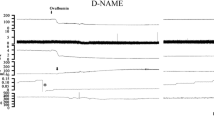Summary
A method is described which allows to induce the symptoms of an anaphylactic shock reaction by injecting Dextrane intravenously into rats. The rats were awake during the experiment and immobilized in special cages, and the Ductus thoracicus was cannulated for the collection of lymph. The permeability of the plasma-lymph-barrier for macromolecules was measured by determination of the concentrations of PVP in the plasma and in the lymph. A pronounced concentration and excretion of PVP in the lymph could be seen in the shocked animals but not in the control animals; this means that the permeability of the capillaries for macromolecules has increased during the shock reaction.
Zusammenfassung
Es wird ein Verfahren beschrieben, an wachen und in Spezial-Käfigen immobilisierten Ratten mit kanuliertem Duct. thoracicus durch i.v. Injektion von Dextran das Zustandsbild eines anaphylaktoiden Schocks zu erzeugen und während des Versuches Duct. thoracicus-Lymphe zu sammeln. Die Permeabilität der Plasma-Lymph-Schranke für Makromoleküle wird durch Bestimmung der Konzentration von PVP in Plasma und Lymphe gemessen. Im Shock stellt sich der Zustand einer gesteigerten Permeabilität für Makromoleküle ein, der — gegenüber den Kontrollen — an der deutlich gesteigerten lymphatischen PVP-Konzentration und -Ausscheidung erkennbar ist.
Similar content being viewed by others
Literatur
Bollman, J. L., J. C. Cain, and J. H. Grindlay: Techniques for the collection of lymph from the liver, small intestine, or thoracic duct of the rat. J. Lab. clin. Med. 33, 1349 (1948).
Vogel, G., u. M. L. Marek: Die Abhängigkeit der mit Polyvinylpyrrolidon und Dextran hervorgerufenen Rattenpfotenödeme vom Molekulargewicht der Substanzen. Arzneimittel-Forsch. 12, 907 (1962).
——, u. H. Ströcker: Die Penetration von Polyvinylpyrrolidon durch die Plasma-Lymph-Schranke bei Ratten. Pflügers Arch. ges. Physiol. 279, 187 (1964).
—— —— Gesteigerte Capillarpermeabilität im tierexperimentellen Modell und ihre Beeinflussung durch Pharmaka. Naunyn-Schmiedebergs Arch. exp. Path. Pharmak. 251, 180 (1965).
—— u. H. Ströcker: Versuche zur Wirkung von Pharmaka auf die Plasma-Lymph-Schranke von Ratten nach Einstellen eines Zustandes gesteigerter Kapillarpermeabilität. Arzneimittel-Forsch. 17, 454 (1967).
Author information
Authors and Affiliations
Rights and permissions
About this article
Cite this article
Vogel, G., Sass, M. Ein tierexperimentelles Modell gesteigerter Capillarpermeabilität. Naunyn-Schmiedebergs Arch. Pharmak. u. Exp. Path. 258, 123–127 (1967). https://doi.org/10.1007/BF00535787
Received:
Issue Date:
DOI: https://doi.org/10.1007/BF00535787




